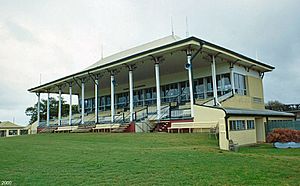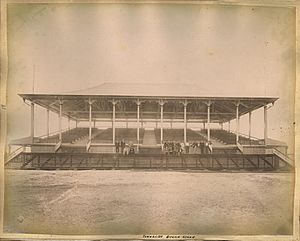Cluden Racecourse facts for kids
Quick facts for kids Cluden Racecourse |
|
|---|---|

Grandstand, Cluden Racecourse, 2000
|
|
| Location | 1 Racecourse Road, Cluden, City of Townsville, Queensland, Australia |
| Design period | 1870s - 1890s (late 19th century) |
| Built | 1896 - 1983 |
| Architect | Walter Howard Tunbridge |
| Official name: Grandstand, former totalisator building and main entrance gates, Cluden Racecourse, Cluden Racecourse | |
| Type | state heritage (built) |
| Designated | 21 October 1992 |
| Reference no. | 600924 |
| Significant period | 1896, 1923, 1927, 1972, 1983 (fabric) 1940s (historical) 1896- ongoing ( social) |
| Significant components | grandstand, totalisator, gate - entrance |
| Builders | Mr Reid |
| Lua error in Module:Location_map at line 420: attempt to index field 'wikibase' (a nil value). | |
Cluden Racecourse is a historic place in Cluden, Townsville, Australia. It's a famous spot for horse racing. The racecourse was designed by Walter Howard Tunbridge and built in 1896 by Mr. Reid. Because of its long history and special buildings, it was added to the Queensland Heritage Register on October 21, 1992.
Contents
The Story of Cluden Racecourse
How Townsville Started
Townsville began in 1864. It was a port and business center for farms in the north. The port grew quickly, and people soon wanted to start sports clubs.
Early Horse Racing in Townsville
The first sports club in Townsville was the Burdekin and Flinders Turf Club, started in 1866. The Governor of Queensland, Sir George Ferguson Bowen, supported horse racing. He believed it helped improve horse breeding and could even help create a strong cavalry (soldiers on horseback).
The first race meeting was a big three-day event in August 1866. Early races were held in different places. In 1874, the government gave the club land for a proper racecourse. The club then changed its name to the Townsville Turf Club, which it still uses today.
Moving to Cluden Park
In the late 1870s, gold was discovered nearby, making Townsville grow even more. A railway line was built to connect Townsville with the goldfields. This railway opened to Charters Towers in 1882.
Leaders of the Townsville Turf Club decided to move the racecourse. They wanted to use the new train service. The new spot, Cluden Park, was close to the Cluden railway station. This made it much easier for people to get to the races. A temporary grandstand was built for the first meeting at the new site. Even though some people had doubts, the new location was a big success.
Rebuilding After a Cyclone
On January 26, 1896, a powerful storm called Cyclone Sigma hit Townsville. It caused a lot of damage. The racecourse buildings were destroyed, and the grandstand collapsed.
The Townsville Turf Club decided to rebuild quickly for their annual race meeting in July. Walter Howard Tunbridge, a famous architect, designed new buildings. These included a grandstand for 700 people, a totalisator building (where bets were placed), a judge's box, and new gates. The old, damaged grandstand was even reused for extra seating.
Thanks to hard work, the new buildings were ready on time. The first race meeting with the new facilities was a huge success! Many people came by train, and a lot of money was bet. People loved the new grandstand and its comfortable lunchroom.
How Betting Worked
The totalisator building was where people placed their bets. This system added up all the bets for a race. Then, it divided the money (after taking a small fee) among those who picked the winning horse. In 1913, an Australian named George Julius invented a fully automated system. This made betting much easier and faster.
Changes Over the Years
After another storm, Cyclone Leonta, hit in 1903, the grandstand needed major repairs. More improvements were added in the 1920s, like a new bar and better restrooms.
During World War II, the racecourse was used as a military camp by the Australian Army. But the army understood how important races were for people's spirits. So, the soldiers would move out every Saturday so the races could still happen!
More repairs and upgrades were done after Cyclone Althea in 1972. In 1983, the facilities got a big makeover. New toilets, drink areas, and a glassed-in viewing area were added. The roof was replaced, but the original seats were kept. These changes made the racecourse even better for everyone.
What Cluden Racecourse Looks Like Today
The main buildings designed by Walter Howard Tunbridge in 1896 still stand today. They have kept their original look and feel, even with all the repairs and upgrades.
The Grandstand
The grandstand is still used today. It has a special roof shape and is supported by timber posts with fancy metal brackets. Inside, the original slatted wooden seats are still there. Underneath the grandstand, there are modern refreshment areas, just like the original ones.
The Totalisator Building
The totalisator building is made of timber and is located behind the grandstand. It has a unique T-shape with different roof sections. It used to be where bets were placed, but now it's used as offices.
The Entrance Gates
One of the original 1896 entrance gates is still the main way into the racecourse. It's made of timber and has two ticket offices on either side. A corrugated iron roof covers the whole structure, matching the other buildings. You can still see hints of its old red and white striped paint!
Why Cluden Racecourse is Important
A Piece of Queensland's Past
The buildings at Cluden Racecourse show how important horse racing was in Queensland's early days. Horse racing was the first organized sport in the colony and in Townsville. In the past, horses were vital for travel and work. Racing helped improve horse breeds and was a popular form of entertainment.
Special Buildings
The grandstand is a great example of its kind. People admired its design when it was built. Together with the totalisator building and entrance gates, these buildings are a special collection of original racecourse structures in Queensland.
Beautiful Design
These buildings were designed by Walter Howard Tunbridge, a very important architect in North Queensland. People have always admired the grandstand's beauty. It has a light and open feel, different from grandstands in other parts of Australia.
A Community Connection
The racecourse buildings are important because of their link to the Townsville Turf Club. This club was the first sports group in Townsville and is one of the oldest in the state. Even after more than a hundred years and many cyclones, these buildings are still used regularly.
Tunbridge's Legacy
The grandstand, totalisator building, and gates are major works by Walter Howard Tunbridge. They show the amazing talent of this important North Queensland architect.


